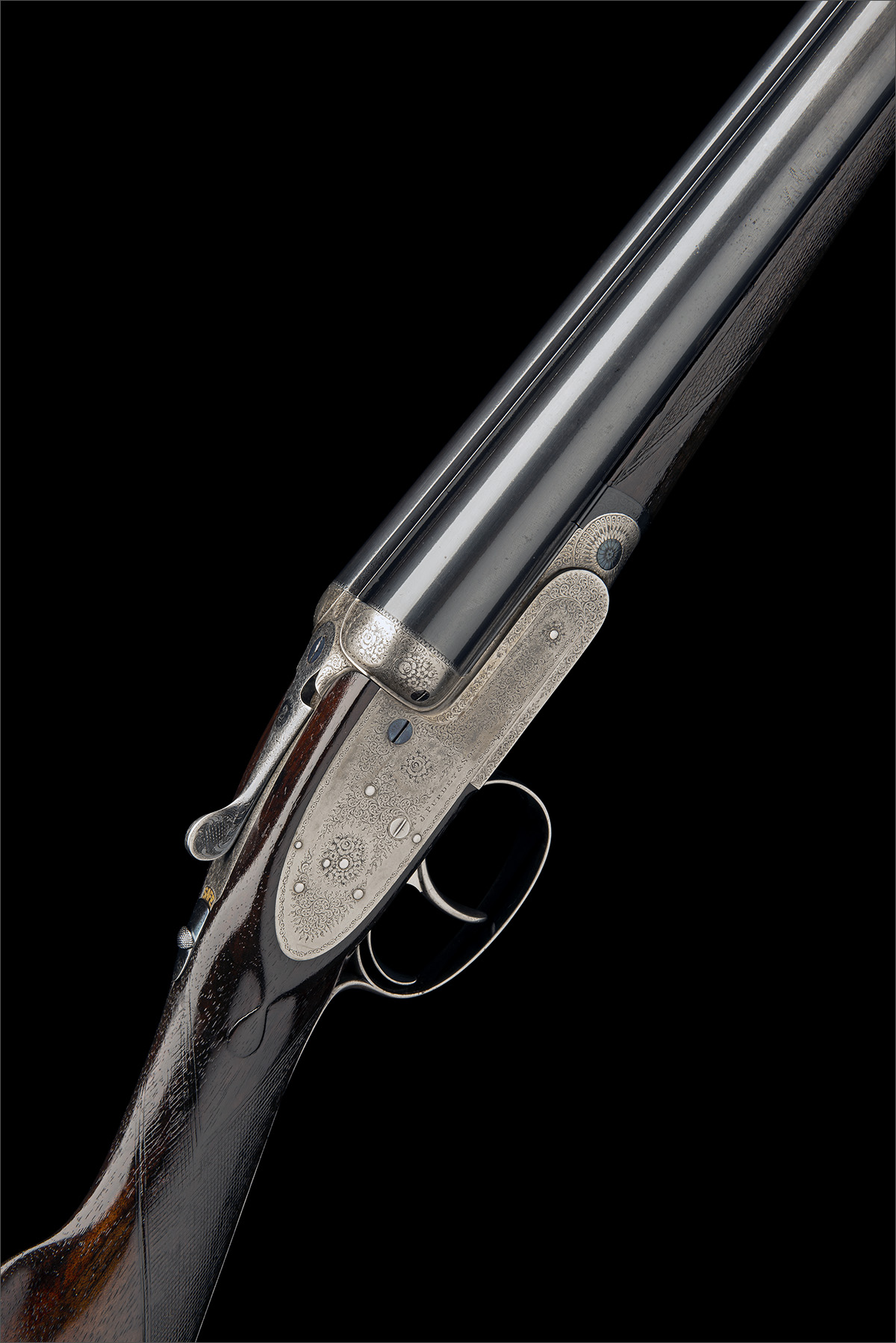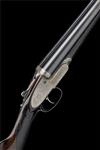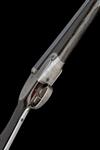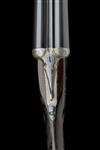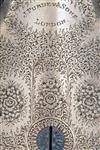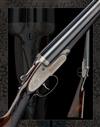Product Details
FORMERLY THE PROPERTY OF MAJOR GENERAL A.J. DEANE-DRUMMOND, C.B., D.S.O. M.C & BAR
J. PURDEY & SONS
A 12-BORE SELF-OPENING SIDELOCK EJECTOR, serial no. 19759,
29in. nitro chopperlump barrels, rib engraved 'J. PURDEY & SONS. AUDLEY HOUSE. SOUTH AUDLEY STREET. LONDON. MADE OF SIR JOSEPH WHITWORTH'S FLUID PRESSED STEEL', and with '2' at the breech end, 2 1/2in. chambers, bored approx. imp. cyl. and full choke, toplever engraved '2', automatic safety with gold-inlaid 'SAFE' detail, removable striker discs, cocking-indicators, best fine acanthus scroll engraving with floral bouquets, retaining very slight traces of original colour-hardening, 14in. figured stock, weight 6lb. 9oz., in a James Purdey brass-cornered oak and leather case (case label for gun No. 21860), the lid embossed 'A. DEANE DRUMMOND'
Provenance: The makers have kindly confirmed that the gun was completed on the 27th April 1910 for a C.A. Cain
The following biography of Major General Anthony J. Deane-Drummond is reproduced with the kind permission of The Pegasus Archive (www.pegasusarchive.org):
Major Anthony J. Deane-Drummond
Unit : 1st Airborne Divisional Signals
Army No. : 71076
Awards : Distinguished Service Order, Military Cross and Bar, Twice Mentioned in Despatches
Tony Deane-Drummond was a member of the Royal Corps of Signals and was attached to the 11th SAS Battalion throughout the early days of the Airborne movement. Then a Lieutenant, he had taken part in Britain's first airborne action, Operation Colossus, a raid to destroy an aqueduct in Italy. In advance of the departure of the raiding party, Deane-Drummond flew to Malta on the 24th January 1941 to ensure that all preparations had been made. The raid itself took place on the 10th February, but after achieving their objective almost all of the paratroopers were taken prisoner, Deane-Drummond was amongst them. He made several attempts to escape before successfully making his way to Switzerland, from where he returned to England. For this endeavour Deane-Drummond was awarded the Military Cross. His citation reads:
This officer was one of a party of paratroops who landed near Calabria in Southern Italy on 10th February, 41. Two days later he was captured and taken to Naples aerodrome from where after interrogation he was later removed to the camp at Sulmona.
On 15th June 1941, Lieutenant Deane-Drummond had made plans to get out of the camp in a garbage wheel-barrow, but had to abandon the idea, as the guards had been warned. In July he again attempted to escape, together with about 20 others, by digging a tunnel, but the scheme was discovered before the tunnel had been completed.
Lieutenant Deane-Drummond made a further attempt to escape in December 1941, accompanied by another officer who was, however, hit by the guard who fired when he saw them climbing over the wire which surrounded the camp. Lieutenant Deane-Drummond got away, and managed to travel as far as Ponte Chiasso before he was detained by soldiers who took him to the frontier post to be searched. Later he was again transferred back to Sulmona, but after a month was moved to the camp at San Romana. Here another plot to escape was discovered and all the English officers were moved to a special camp south of Naples. Lieutenant Deane-Drummond, however, had managed to be sent to hospital at Florence a few days before the party left. Here he was left locked in a room on the fourth floor with a guard outside the door. On 15th June 1942, he escaped from the room by sidestepping along the ledge outside his window, entering another room some distance away, and going downstairs and out through a window on the ground floor. Dressed in battle-dress, trousers and a navy blue sweater he travelled by train to Varese, changing at Milan, and walked towards the frontier. After seeing what he thought were sentry boxes, he decided to return to Varese and travel on towards Como. He was stopped by a Mareschallo (Regimental-Sergeant-Major) while passing through a village but was allowed to proceed. He reached Ponte Chiasso and at night on the 19th June he managed to scoop enough earth to allow him to get under the frontier wire
He intended to try to get to Berne without giving himself up, but at Chiasso he was stopped by a Swiss policeman and after questioning, he admitted that he was an escaped British prisoner. He was taken to Berne on the same day and after further questioning was handed over to the British authorities for repatriation.
By 1944, the twenty-seven year old Deane-Drummond had acquired the rank of Major and was Second-in-Command of the 1st Airborne Divisional Signals. As soon as he and his fellow signalmen saw the proposed Operation Market Garden plan they were immediately concerned about the distance from the drop zones to the bridge, as they knew that the limited range of their radio sets would result in a blackout between the two areas until on the second day, when the Division was able to advance on Arnhem. To overcome this problem, Deane-Drummond would have liked to have taken more of the powerful Jeep-mounted Type 19 sets that, at present, only the gunners of the 1st Airlanding Light Regiment used. However to take more of these would require additional gliders, of which there were none, and the planning phase for Market Garden was so short that there was no time to work a way around this problem, so Divisional Signals therefore had to make do with what they had. Deane-Drummond noted after Arnhem that absolutely everyone was so keen to get into battle, after so many previous cancellations, that many such risks were knowingly taken.
Upon arriving in Arnhem, Deane-Drummond was pleased to discover that their radio sets appeared to be working perfectly, but as the 1st Parachute Brigade moved closer towards Arnhem the clarity of their signals began to deteriorate rapidly. Although the Brigade was only two or three miles away at this stage, the medium-range jeep-mounted Type 22 sets were not able to make contact with them at all. Major Deane-Drummond ordered one of these sets to be driven forward, half way between Divisional Headquarters and the 1st Parachute Brigade, in the hope that messages could be relayed back and forth, however the signal from this jeep quickly faded away.
On Monday 18th September, to inform them of a new radio frequency for the day, Deane-Drummond left Divisional HQ and set out to where the remains of the 1st Parachute Brigade were continuing their efforts to break through to the Bridge. When he reached Arnhem he encountered a small group of leaderless men from the 3rd Battalion who were in the process of pulling back from the fighting. He immediately took command of them and led them forward to within sight of Arnhem Bridge, however they soon came under fire and were forced to full back. They probably did not know it at the time, but they had made the deepest advance into the town that the Brigade had managed on that day. In danger of becoming trapped, Deane-Drummond split his remaining twenty men into three groups and ordered them to hide until nightfall. He intended to emerge with his party in the night, swim to the southern bank of the Rhine, where enemy activity seemed less intense, and then head westwards until he was opposite the Division's positions in Oosterbeek, where he would attempt to cross back over again.
Deane-Drummond took three men with him, one of which was his batman, and sheltered in a small house, just eight-hundred yards from Arnhem Bridge. Whilst they were here, German soldiers entered the building and proceeded to fortify it for defence. They were completely unaware of the presence of the British, who had quickly disappeared to the rear of the house and locked themselves inside a lavatory. The handle was tried several times, but no attempt was made to force it.
The group remained in this small room for three days until, with their boots wrapped in their battle dress to dull any noise they might make, they crept down the stairs and left the house. The group split up with the intention of finding their own way across the Rhine and then meeting up on the opposite bank. Deane-Drummond stripped off his clothes, tied them up inside his Denison smock, and then successfully swam the River. He dressed himself on the other side and proceeded to head westwards, over several fields and through an orchard. Eventually he heard German voices and found himself passing a line of slit trenches that had been dug near the Railway Bridge. It was at this point that he fell into one of these trenches and landed right on top of a German soldier. Deane-Drummond immediately drew his pistol and shot the man in the head, but he was unable to escape because another German arrived on the scene immediately. Reasoning that he was fair game for a bullet at this point, Deane-Drummond was somewhat surprised to be taken prisoner and not killed, perhaps because the other man did not know that the German he was lying on top of was dead and so was fearful of harming him.
Major Deane-Drummond was escorted to a temporary POW shelter in Velp, some miles to the east of Arnhem. Whilst being marched away on Friday 22nd September, the column of some two-hundred prisoners that he was with were halted in the grounds of a house and counted. Not a man to lie back and accept his fate, Deane-Drummond spotted a large cupboard and immediately dived into it. For no less than thirteen days he stood inside this cupboard, rationing himself on a few biscuits and sips of water, until the 5th October, when he was able to make good his escape. Cautiously, he first hid in a garden outside this building, not feeling at all weary from his ordeal. Before long he made contact with the Dutch Resistance, who hid him until the 22nd October when, together with the one-hundred-and-thirty-seven other men of Operation Pegasus in hiding, he crossed the Rhine and rejoined the Allies. For his role in Market Garden, Deane-Drummond was Mentioned in Despatches and awarded a Bar to the Military Cross. The Mentioned in Despatches citation reads:
After swimming across the Rhine to avoid capture, Major Deane-Drummond walked into some German trenches and was taken prisoner on 22nd September 1944. He was marched to a Prisoner of War camp, which was a house at Velp. Here he discovered a cupboard concealed by wallpaper, and on 23rd September he locked himself in, remaining there for eleven days. During this time he existed on one-third of a loaf of bread, and a bottle of water. He emerged on 4th October, when all Prisoners of War had been evacuated, and left the house through a window. He was given hospitality in various houses until he joined a party which was evacuated on 22nd October.
In May 1990, Deane-Drummond wrote the following letter to the Journal of the Royal Signals Institution in response to what he regarded as a well-researched article which the journal had published about the communications problems at Arnhem.
Every single airborne operation undertaken before Operation Market Garden had emphasised that lightly equipped airborne troops must be landed either on or very close to the objective. This precept was not carried out at Arnhem and led directly to the fiasco. The reasons for this need to be examined.
Unfortunately there was a highly suitable 'Salisbury Plain' type DZ some eight miles to the west of the Arnhem Bridge with a dense forest and the large town of Arnhem to pass through before getting to the Bridge. The alternative area immediately to the south of the Bridge and on the line of advance of 30 Corps, was relatively flat with drainage ditches round the fields and a few scattered houses. It was ideal for parachute troops but there would have been more landing crashes for the gliders. The RAF was mesmerised by the Western DZ and put forward many reasons why it had to be chosen. In particular, air photographs showed numbers of AA positions round the Bridge. Many of these positions were dummies (as I saw for myself during the battle) and the official RAF report in January 1945 acknowledges that this was suspected at the time but not mentioned in their briefings. The RAF considered that at least 10 per cent of the aircraft and gliders would be shot down before dropping or landing - in spite of Allied air superiority at the time.
During the very short planning phase of some ten days, General Browning (commanding 1st Airborne Corps) was well aware that General Urquhart commanding 1st Airborne Division was not an experienced airborne commander, so he invited General Gale (who was very experienced and had also commanded 6 Airborne Division in its successful airborne assault into Normandy some three months before) to come to his HQ at Moor Park and comment on the alternative dropping zones. He told Browning, 'The whole Division would have to be landed on or close to the Bridge to be certain of success or at the very least a coup de main drop of a parachute brigade to hold the Bridge until the main force arrived.' 'Without such a drop, the chances of success were slim.' he thought. He was particularly critical of the drop over two days and this emphasised the need to use the area to the south of the Bridge. (Discussion and personal letter to me from Major Norton).
There is no doubt that General Gale's views were not passed on to General Urquhart who considered that the RAF's job was to get the Division safely to the DZ; his job would then start. (Personal letter to me from Major General Urquhart in 1988).
With regard to communications, some eight months before Arnhem and after our return from Italy, I proposed that the main Divisional Command nets would need the normal infantry Division issue of No 19 and 19 HP wireless sets, if we were to be used spread out as in Italy. This was turned down flat by the staff who stated that 'the Division would always operate within a three-mile perimeter.' If we had been re-equipped with more powerful radios, it would have added a minimum of an additional glider for each brigade and probably two for Divisional HQ. Spares might have doubled this allocation. A total of twelve extra gliders would be needed for Signals.
The use of the Division at short notice required all units to stick to a standard loading of gliders. It was not possible to switch loads around or change equipments. For security reasons, I heard of the plan only 36 hours before take off. I immediately contacted my Commanding Officer, Tom Stephenson. I told him we were unlikely to have proper communications until the whole Division was concentrated round the Bridge. I asked his permission to see the General or at least the GSO 1. I was told it was too late to worry them. He told me firmly to do no such thing. He was probably right.
Unfortunately General Browning had not commanded any formation during the war to date. He was determined to take his Corps HQ to battle at two weeks notice although it had only been designed to operate as a static HQ at Moor Park. (Personal letter to me from Major General Moberley). Tactically this was ridiculous and unnecessary. Links to the airborne divisions could have been better served direct from 30 Corps. Unfortunately the 38 gliders needed (of which 35 arrived), could have provided invaluable support to assist 1st Airborne Division on the first day. As a coup de Théâtre it might have been dramatic; as a means of waging war against a background of an acute shortage of aircraft, it was absurd.
The Arnhem debacle was caused by the complete failure of strategy and tactics at senior level. It was nothing to do with Signals. If we had landed adjacent to the Bridge and to the south of it, the Division might have had 10-20 per cent landing casualties. There would have been no problem with communications. The Division would have survived and would easily have held on to a bridgehead at Arnhem. The war might even have been shortened - but this correspondent might not be here to tell the tale.
Tony Deane-Drummond
c/o RHQ Royal Signals,
May 1990
Tony Deane-Drummond continued to serve in the Armed Forces after the War and, as a Lieutenant-Colonel, commanded the 22nd SAS in the later stages of the Malaya Emergency. Under his guidance, this unit became expert at living deep in the jungle, from where they were able to inflict terrible damage upon the communist guerillas. In future actions he commanded the Regiment in Oman, where their spectacular success resulted in him being awarded the Distinguished Service Order. His citation reads:
When, on the 1st January 1959, Lt-Colonel Deane-Drummond arrived in Oman to command two Squadrons of his regiment, rebels were holding the JEBEL AKHDAR : a formidable mountain range rising to 10,000 feet. All known tracks up the very steep slopes were dominated by rebel piquets, which had defied earlier attempts to dislodge them.
After successful patrol actions during the month Lt-Colonel Deane-Drummond on the night of 26th/27th January, took personal command of an assault of the JEBEL AKHDAR. By a forced night march up extremely difficult country, he surprised the enemy and gained complete success. At one stage the ascent was possible only by using ropes. Moving immediately behind the leading troops, Lt-Colonel Deane-Drummond by his courage and leadership throughout the assault, and on the following days, inspired men by his example. The remaining rebel opposition was quickly overcome and the whole operation was completed at small cost to the attacking troops.
Towards the end of the 1950's, he was promoted to Brigadier and took over command of 44th Parachute Brigade (TA) from John Frost, who was later destined to play the deceitful friend who brought Deane-Drummond to London under false pretences before handing him over to Eamonn Andrews, presenter of the This Is Your Life television programme; for his trouble, Frost received the customary bout of good humoured curses. A British gliding champion and author of the book, Return Ticket, Tony Deane-Drummond concluded his military career at the rank of Major-General.
Other Notes: Barrels: 73.5cm
Chambers: 65mm
Stock length: 35.5cm
Weight: 2.976Kg
Functions with snapcaps: yes
Please click HERE to view Terms & Conditions.
Estimate £5,000-7,000
S2 - Sold as a Section 2 Firearm under the 1968 Firearms Act

